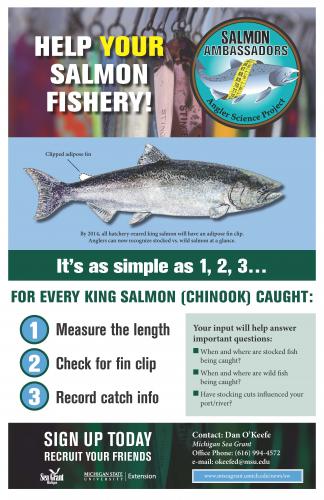Three simple steps to help your salmon fishery
The Salmon Ambassadors program enlists anglers to gather information on Chinook salmon caught over the course of the year to help biologists understand how stocked and wild fish contribute to fishing success at individual ports during the fishing season.
Great Lakes salmon fishing has had its ups and downs in recent years. On one hand, catch rates for Chinook salmon have been relatively high for the past nine years in Lake Michigan. On the other hand, size of mature salmon has varied from year to year. Years with very high catch rates, small salmon, and slow growth rates indicate that there  may be too many salmon and not enough prey.
may be too many salmon and not enough prey.
This was the situation in Lake Huron before salmon numbers crashed in 2004. Alewife, the primary prey of salmon, all but disappeared from Lake Huron, in part, due to increasing natural reproduction of Chinook salmon.
Chinook salmon are a non-native species that is stocked in Great Lakes waters and tributaries, but they also reproduce naturally in certain high-quality rivers and creeks. If too many salmon are stocked on top of wild-spawned salmon, it is possible for them to deplete their own prey.
In order to avoid this situation in Lake Michigan, the decision was made to reduce Chinook salmon stocking by 50 percent in 2013. This decision was made by state and tribal agencies in collaboration with anglers in Michigan, Wisconsin, Illinois, and Indiana. Now anglers are being asked to participate in another sort of collaboration for the good of their fishery.
The Salmon Ambassadors program enlists anglers to help biologists answer critical questions. Three simple steps are all it takes to provide information that will lead to better understanding of how, when, and where wild and stocked salmon are contributing to your fishery.
Any angler who regularly catches Chinook salmon can participate by doing the following for each and every Chinook salmon caught over the course of the 2014 season:
- Measure fish carefully from the tip of the snout to tip of the tail.
- Check for an adipose fin clip that indicates a stocked fish.
- Record length and clip info along with date and location of catch.
To sign up and volunteer as a Salmon Ambassador, or to request more information, contact Dan O’Keefe with Michigan Sea Grant. As a volunteer, you will receive a binder containing data sheets and instructions along with information on the status of the salmon fishery. After the end of the season, you will be sent a report describing results from your port and others around the lake.
The Salmon Ambassadors program is a Michigan Sea Grant initiative developed in collaboration with Michigan State University Extension, Michigan Department of Natural Resources, Michigan Steelhead and Salmon Fishermen’s Association, and Wisconsin Sea Grant.



 Print
Print Email
Email

